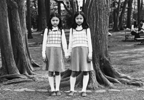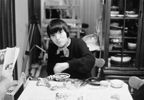New Asian Currents Juror
Sato Makoto
 [Juror’s Statement]
[Juror’s Statement]
Documentaries are mirrors that reflect the world critically. They are not tools for social change or weapons for political statement, but rather “a critique through visual expression,” an action of gazing persistently at the ways of the world with a dispassionate eye. This is my modest rule of thumb as a documentarist. And so its critical nature corresponds sharply to the fact that there is no “truth” and that reality already involves fiction. Even if an innocent piece of reality is reflected in film footage, by recomposing that reality the film becomes nothing other than fiction. I think that the critical nature of documentary films depends on the way reconstructed fiction presents reality in a critical light.
|
Sato Makoto
Born in Hirosaki, Aomori, Japan in 1957, and raised in Tokyo. Encountered documentary film when he visited Minamata as a student, and worked on Katori Naotaka’s The Innocent Sea. While touring Japan with the film, met people who lived by the Agano River in Niigata and decided to make a film about them. Lived with seven crew members for three years and in 1992 completed Living on the River Agano, which won a number of awards including the Prize for Excellence at YIDFF ’93. Has made several TV works since, though films are hard to come by. His work Artists in Wonderland (1998) screened at Japanese Panorama YIDFF ’99. Recent publications include Mirror Called Everyday and The Horizons of Documentary Film (Gaifusha). |
SELF AND OTHERS
 JAPAN / 2000 / Japanese / Color / 16mm / 53 min
JAPAN / 2000 / Japanese / Color / 16mm / 53 min
Director: Sato Makoto
Photography: Tamura Masaki
Editing: Miyashiro Shigeo
Sound: Kikuchi Nobuyuki
Music: Kyomaro
Narrator: Nishijima Hidetoshi
Producer: Horikoshi Kenzo
Production Company, Source, World Sales: Eurospace
24-2-7Fl. Sakuragaoka-cho, Shibuya-ku, Tokyo 151-0031 JAPAN
Phone: 81-3-3461-0212 Fax: 81-3-3770-4179
URL: www.eurospace.co.jp
In 1983, photographer Gocho Shigeo met an early death at the young age of 36. The view we see reflected in Gocho’s photographic images has become more profound over time since his death and has struck a chord in people’s hearts. While focusing on Gocho’s collection of photographs Self and Others, the film also visits places associated with him, creating a collage with the manuscripts, letters, photographs and voice recordings remaining in an attempt to capture “one more gesture”—a theme pursued by Gocho through photographic expression.
This film is neither a critical biography nor a monograph on the photographer. Rather, we are offered a new perception. As if mesmerized, the photographs Gocho left behind captivate us in their gaze.
Hanako
 JAPAN / 2001 / Japanese / Color / 35mm / 58 min
JAPAN / 2001 / Japanese / Color / 35mm / 58 min
Director: Sato Makoto
Editing: Hata Takeshi
Sound: Tsurumaki Yutaka
Producer: Yamagami Tetsujiro
Production Company, Source, World Sales: Siglo, Ltd
5-24-16 #210 Nakano, Nakano-ku, Tokyo, 164-0001 JAPAN
Phone: 81-3-5343-3101 Fax: 81-3-5343-3102
E-mail: siglo@cine.co.jp URL: www.cine.co.jp
Imamura Hanako is a twenty-two-year old girl with severe autism who lives in Yamazaki in Kyoto Prefecture. Once a week she attends a painting class, where she paints bold pictures in oils. In another vein, though, every evening after dinner she also continues to create the works that her mother, Chisa, has named “food art.” This may only involve arranging the leftovers from the day’s meal on the floor or a tray, but Hanako’s mother records the works every day, so that there are now some thousands of photographs that have been accumulated. This collection of photographs has been exhibited around the country, and has begun to receive the attention of professional artists. By focusing on Hanako, following her daily life in the routine of the four members of the Imamura family, we see the portrait of the family “unfolded” to us. And so to this day, Hanako continues creating on the floor what some unknown person called her “discerning art.”
